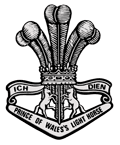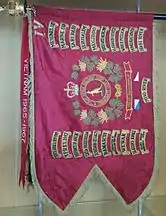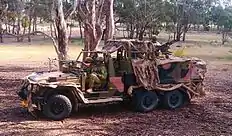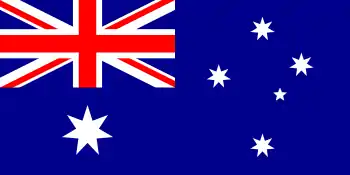4th/19th Prince of Wales's Light Horse
The 4th/19th Prince of Wales's Light Horse (4/19 PWLH) is a cavalry regiment of the Australian Army. The regiment in its current composition was formed in 1948 when the Citizens Military Force (CMF) was re-raised after the completion of the demobilisation process following the end of the Second World War and it was formed through the amalgamation of three previously existing regiments. Through these predecessor units, 4/19 PWLH can trace its lineage back to the 19th century and today it is the custodian of the battle honours earned by these units. The regiment had a Regular squadron, 1 Troop 4th/19th Prince of Wales Light Horse Regiment, which was posted to South Vietnam in 1965 where it was attached to 1 RAR operating out of Bien Hoa Province. It returned to Australia on 28 May 1966 and became part of the Regular cavalry units that continue to exist in the Australian Army today. These units subsequently served during the Vietnam War and many of their personnel continued to wear regimental accoutrements while in South Vietnam.
| 4th/19th Prince of Wales's Light Horse Regiment | |
|---|---|
 Cap badge of the 4th/19th Prince of Wales's Light Horse | |
| Active | 1948 – present |
| Country | |
| Branch | Army Reserve |
| Type | Light horse |
| Role | Light cavalry |
| Size | One regiment |
| Part of | 4th Brigade |
| Garrison/HQ | Melbourne |
| Motto(s) | Ich Dien (I Serve) |
| Colours | Red, white |
| March | Australian Light Horse |
| Engagements | Vietnam War |
| Commanders | |
| Current commander | Lieutenant Colonel John Pearse, CSM |
| Colonel-in-Chief | The Prince of Wales (Colonel-in-Chief, RAAC) |
| Insignia | |
| Unit colour patch |  |
Today 4/19 Prince of Wales Light Horse Regiment is an Australian Army Reserve regiment and forms part of the 4th Brigade, 2nd Division based in Victoria. As part of the restructure of the Royal Australian Armoured Corps (RAAC) units of the Australian Army Reserve it is now equipped with Bushmaster Protected Mobility Vehicles.
History
The regiment was formed in 1948 as the 4th/19th Armoured Regiment (Prince of Wales's Light Horse) as a unit of the Citizens Military Force through the amalgamation of three other regiments: the 4th (Corangamite) Light Horse, the 17th (Prince of Wales's) Light Horse, and the 19th Light Horse (Yarrowee Light Horse).[1] Through these, the regiment can trace its lineage through many units, including: the Kyneton District Mounted Rifle Corps, the Royal Volunteer Cavalry Regiment, the 17th Light Horse, the 17th Prince of Wales Light Horse, the 19th Yarrowee Light Horse, the 20th Corangamite Light Horse, the 4th Corangamite Light Horse, the 4th Light Horse AIF,[2] and the 2/4th Armoured Regiment.

The record of the 4th Light Horse in the 1914–18 war is without equal in the Australian Imperial Force. It was the only Australian unit to see service on all three fronts, Western Front (France), Gallipoli and Palestine and was granted a total of 24 Battle Honours of which 10 are carried on the guidon. Probably the most notable action of the 4th Light Horse was as part of the 4th Light Horse Brigade, the charge at the Battle of Beersheba on 31 October 1917, where 800 Australian Lighthorsemen took the town and crucial wells of Beersheba. This action is commemorated each year by the serving soldiers of the Regiment.
The regiment assumed its present name in 1949. In 1960, a regular squadron, A Squadron, was added to the regiment. In 1965, this was removed from the regiment's order of battle—Number 1 Troop was used as the nucleus in the formation of 1st Armoured Personnel Carrier Troop during its deployment to Vietnam,[3] while the rest of the squadron was used to form 2nd Cavalry Regiment.[4] Later, 1 APC Sqn would be used to form the 3rd Cavalry Regiment.[5]
In 1992, 4th/19th Prince of Wales's Light Horse Regiment underwent another major restructure when it was linked with Victoria's second Armoured Reserve Unit, the 8th/13th Victorian Mounted Rifles (8th/13th VMR). Before this restructure, 8th/13th VMR had its HQ and 1 Troop based in Albury, 2 Troop based in Wangaratta and 3 Troop based in Benalla. After the linking, 8/13th VMR became 'A' Squadron, 4/19th PWLH.[6]

Today, the regiment maintains two Sabre squadrons: 'A' Squadron, which is based in Sale and Bandiana, and 'B' Squadron, which is located in Melbourne. On 28 April 2008, a Lance Guard consisting of members of 4/19 PWLH and 12/16 HRL was involved in the dedication of the Park of the Australian Soldier in Beersheba, Israel. The park includes a bronze statue of a lighthorseman involved in the Charge of Beersheba on 31 October 1917. This event was the first time the Regiment's Guidon has travelled overseas. The regiment has been granted the Freedom of Entry to five cities: Melbourne, Kyneton, Beechworth, Traralgon and Sale.
The unit operated M113 Armoured Personnel Carriers until 2007, after which its role was changed to a light cavalry unit. It then operated modified Mercedes-Benz G-Wagon 6x6 Surveillance Reconnaissance Vehicles and Bushmaster Protected Mobility Vehicles (PMVs). G-wagons are no longer used, and the Regiment only operates PMVs as well as training cavalry scouts for the Regular Army battlegroups.
Alliances
See also
Notes
- Festberg 1972, p. 16.
- Festberg 1972, pp. 16, 41, 51–52.
- Moodystack 2003, p. 1.
- Hopkins 1978, pp. 237–238.
- Festberg 1972, p. 12.
- "The 8th/13th Victorian Mounted Rifles". Digger History. Archived from the original on 1 January 2011. Retrieved 18 May 2014.
References
- Festberg, Alfred (1972). The Lineage of the Australian Army. Melbourne, Victoria: Allara Publishing. ISBN 978-0-85887-024-6.
- Holloway, David. (1990). Hooves, Wheels and Tracks: A History of the 4th/19th Prince of Wales's Light Horse Regiment and its Predecessors. Regimental Trustees: Fitzroy. ISBN 0-7316-9042-7.
- Hopkins, Ronald (1978). Australian Armour: A History of the Royal Australian Armoured Corps 1927–1972. Canberra: Australian Government Publishing Service. ISBN 978-0-642-99414-1.
- Moodystack, Neville. (2003). The Pony Soldiers: The Australian Light Horse. Vietnam 1965–1966. Australian Military History Publications. ISBN 1-876439-57-2.
Further reading
Enright, Stuart (22 May 2014). "Reservists' new PMVs". Army: The Soldiers' Newspaper. p. 11. ISSN 0729-5685. Retrieved 19 May 2014.
